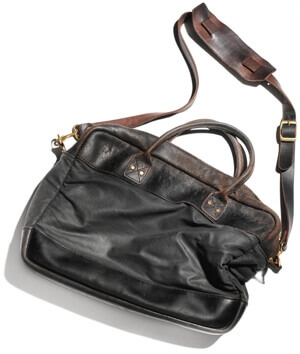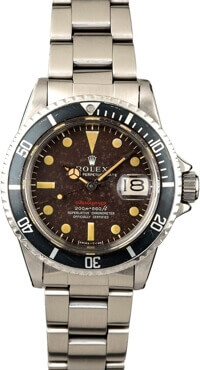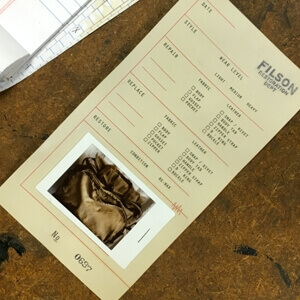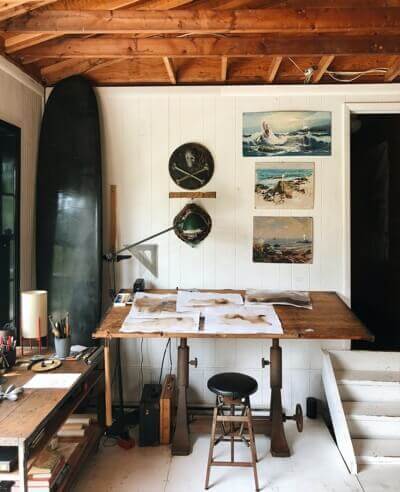What Is It
About Patina?

What Is
It About Patina?
The next new thing is great, but you can’t beat items that get better with age
There are some things you want brand new and unblemished. Items like iPhones, beds or underwear are best when pulled fresh from their original packaging. But there's something to be said for those items that only get better with age. Perfectly imperfect, they might be a little faded, they could be chipped or scuffed, frayed or peeling. Perhaps they've even been mended or patched over time.
These are the items we love to describe as having “character.” But there's an interesting duality to this character. It might be considered evidence of shortcomings in manufacture and materials, or it could be seen as proof of an item's ability to withstand sustained abuse. It's a reminder that anything worthwhile—be it a garment or watch, a piece of furniture or a human being—has an innate ability to endure.



Like a well-worn piece of leather, a person who's struggled might be a bit rough around the edges, they may have some cracks in the facade, but other parts are smooth and soft, having learned from what they've encountered. A man's ego can be bruised, his nerves frayed and integrity chipped away at ... but if after all that, he's still standing? Then he's no worse for all that wear.
Wear is exactly how Chris Bray, who founded Billykirk with his brother Kirk in 1999, measures time. “For me, time doesn't just represent minutes in a day or months in a year—it's the life of an item, whether it's boots, a wallet, or your raw selvage denim jeans,” he says. “That time you invest in your denim or leather item begins to show through use—your travels, experiences, labor and everything in between.”


True patina has to be earned, says Brian Davis, the vintage dealer and owner of Wooden Sleepers. “There are no shortcuts,” he says. “No matter how advanced technology becomes in distressing materials—lasers, chemical treatments, etc.—there's just no substitute for the real experience of wearing in your stuff.” Bray agrees. “After all, it's the oils from your skin and the repeated daily use that cause those personalized wear patterns and patina.”
When it comes to buying vintage clothes, some would consider “deadstock” the holy grail. Unearthing a perfectly preserved piece from the past in a pristine, unworn condition oftentimes with the original hangtags still intact, makes for a very cool time capsule of sorts. But there's not much humanity to it. No past life. “On the opposite end of the spectrum is a piece that has been worn and mended, patched and repaired countless times, creating a truly one of a kind piece,” says Davis. “These repairs and modifications are often a reflection of the owner—who they were, what type of profession they had, and how they spent their time.”
Think of the phenomenon of the barn-find car. Motoring critic Robert Ross says they excite the imagination unlike any other kind of automobile. Why? Because it's like discovering buried treasure. These aren't sparkling dream cars, fresh from restoration or those lovingly maintained by lifetime owners. They're relics hidden from view for decades and often forgotten until a creaking door of a dilapidated garage is opened to reveal a classic car blanketed with years of dust. They're anything but perfect—the paint is speckled and chipped, the seats worn and faded. But that's exactly what makes them so unique and desirable.
Advertisement



There is something irrational in the reasoning by which the barn find is sometimes valued more than its shiny, fully-restored equivalent. But the same thing happens with watches. Take, for example, the tropical dial timepieces. During the 1960s, Rolex, Omega and a handful of other high-end watchmakers sourced dials from a manufacturer that used a particular black paint that would later go on to fade dramatically when exposed to years and years of UV rays. The black would fade and freckle into shades closer to chocolate brown—this supposedly started happening in tropical environments first, thus the “tropical” name given to the patina.
Initially, these faded dials were considered defective. Rolex and Omega would even swap them out during servicing. But then the vintage-watch market took off and savvy collectors began appreciating the organic nature of the dials and the soulful quality of a watch that has a story behind it. According to Paul Altieri, the founder of Bob's Watches, there's a certain intangible aspect to vintage watch collecting that's rooted in the watches' individual histories and the lives that their past owners have lived. Which is why a Rolex Submariner with a brown tropical dial can run about twice as much as a standard one.
My first Rolex had to be old. I didn't want some big, flashy new one. In fact, I had my heart set on one that wasn't even being produced at the time. I'd been eyeing the streamlined style of the Air-King model for years. After doing some research, I finally found the perfect one at a Chicago jewelry shop specializing in vintage watches. Funnily enough, my Air-King just happens to be from the same year I was born. When I got it, it was in good condition, but you could see it wasn't new. It was somehow softer. Tiny scratches made it feel less precious. And it fascinated me to think about how we'd both been on the Earth for 32 years, living very different lives but coming together at just the right time.
Advertisement
Bray see the psychology in it all. “I humbly believe there's another interesting layer to all of this,” he says. “Your wallet is, at first, an inanimate object. It has one purpose, one job. But over time, that object becomes something more—it's got stories of your adventures, it's a conversation piece and a travel companion—it becomes a part of you.” He knows this because Billykirk often hears from their customers years later, with stories of the lives their leather items have lived.



You see the lives such beloved items live up close and personal at the Filson restoration department at the brand's Seattle headquarters. It's here that they repair bags for customers or save decommissioned products from the junk pile to sell. On my first visit, I marveled at the work being done in the workshop. How the workers creatively stitch back together broken straps, reinforce busted seams and patch worn-through holes. You can see the slight differences in a bag from the '70s compared to one from say, the late '90s. They're subtle, but they're evident in the stitching or zipper choice. The quality craftsmanship, however, remains the same. It speaks to a time when things were built to last and be serviceable, not replaceable.



Of course, an item has to be of a certain quality to be able to earn that patina. It must be strong enough to endure. It's about battle scars, not looking battered or broken. “Patina and provenance immediately signals a quality to the piece,” says interior designer Colin King, who specializes in perfect imperfections. “Most patina shows up from hand finishes using traditional methods and organic compounds, no synthetics. These finishes are considered living finishes and will uniquely change over time depending on exposure to the elements, handling, and cleaning routine.”
King realizes, especially working for clients with varying tastes, that an interest in vintage or patina is a very subjective thing. “With vintage, it's important to find that modern twist and the magic contrast between old and new.” Bringing in something with some soul from a previous life—a rustic repurposed table, frayed rugs, antique boxes dulled and dented—will give any home a more worldly, curated vibe. It's what makes a space look cool and feel warm. It gives you something to talk about with guests. It becomes something you live with for long enough to love it.
Which is exactly what patina is—evidence of a life well-lived. Why would we ever want to toss it or polish it away? I say let's show off the flaws and celebrate the fact that it's still here and will no doubt be around for a long, long time.
Mary Randolph Carter, a longtime executive at Ralph Lauren and avid collector, wrote the book For the Love of Old, which includes ideas for saving old items from the junk pile, giving newer things a lived-in feel, and preserving and caring for the old things you have.



